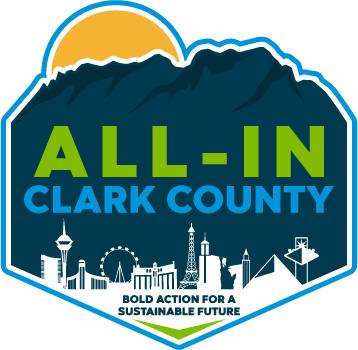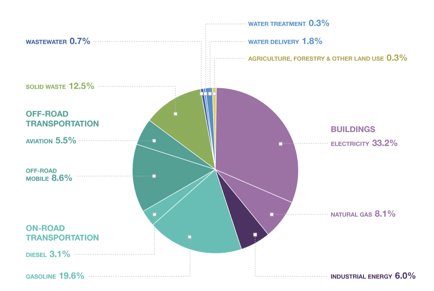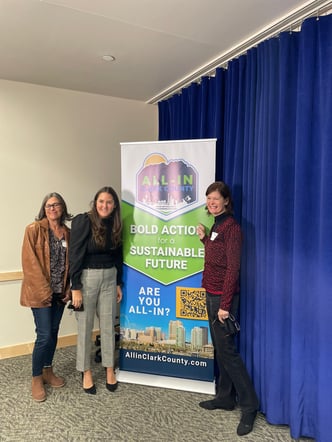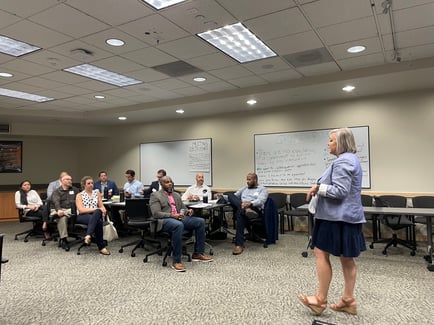
KLA clients lead the way with innovative, scalable, replicable climate solutions at the local level.
Each month in 2022 we will shine a spotlight on their bright ideas.
To ensure the All-In Sustainability and Climate Action Plan is implemented and has impact, Clark County takes a more proactive, inclusive and data-driven approach to community and stakeholder engagement.
The Basics:
Gone are the days when local governments can slow roll a climate planning process. Where only token representatives from a few key sectors are invited to participate. Where a plan is developed and then shopped around for buy-in. Where the plan’s many actions are actually just “do more assessment and planning.”
That more traditional model leaves you with a tremendous amount of difficult work to do after the plan is passed. With only a few years to embrace ambitious climate action and more of the burden falling on cities, towns and counties, we have to be much more intentional with community and stakeholder engagement and smarter with our time and planning processes.
We need actionable plans.  To move more swiftly to implementation, local governments can leverage data and stakeholder engagement to be more proactive in the planning process. That’s what we’ve been helping do with Clark County, Nevada, and their All-In Community Sustainability and Climate Action Plan.
To move more swiftly to implementation, local governments can leverage data and stakeholder engagement to be more proactive in the planning process. That’s what we’ve been helping do with Clark County, Nevada, and their All-In Community Sustainability and Climate Action Plan.
This is especially critical for a county like Clark County, including five cities, three tribal nations and a ton of federal land (hello, Hoover Dam!). They simply cannot successfully take action on climate change alone. A strong building code or a new electric vehicle ordinance passed by the County won’t do much on its own if cities from Las Vegas to Mesquite and across 8,000 square miles don’t adopt similar measures.
So how do you write a Climate Action Plan knowing you don’t control a lot of it? Deep, ongoing collaboration.
Keys to Success:
Data-Driven to Drive Buy-in and Impact
It’s common practice to bring stakeholders in to get background information and general feedback from them as it relates to this aspect or that topic of a plan. But that more generic feedback doesn’t give key players an opportunity to meaningfully contribute, and you’ll wind up having to circle back to them again – wasting their time and yours. You can get so much more value out of stakeholders’ expertise and connections if you do a bit more legwork in advance and set the bar higher for their participation. Think of stakeholder engagement as building capacity for implementation. For All-In, Clark County goes into stakeholder meetings having completed a data analysis that presents a full picture of the region’s climate vulnerabilities and opportunities, including information on the biggest sources of greenhouse gas emissions and most impactful actions. (For more on KLA’s data-driven approach, read this.)
For All-In, Clark County goes into stakeholder meetings having completed a data analysis that presents a full picture of the region’s climate vulnerabilities and opportunities, including information on the biggest sources of greenhouse gas emissions and most impactful actions. (For more on KLA’s data-driven approach, read this.)
This takes the “why” off the table along with a good chunk of the “what” so that the focus can be on the “how”. They can bring in key players related to a particular sector (i.e. transportation), look at the data on related emissions sources (i.e. cars) and options for reductions (i.e. EVs) , and tap into local expertise to craft actions that will have the most impact and be most likely to move forward. Drilling down into the “how” is key to developing an actionable plan.
Jumpstart Implementation by Building Consensus Early
Overall community engagement for All-In has been robust, including: a mix of virtual and in-person events like a County Employee Lunch and Learn (utilizing Mentimeter); seven online virtual forums focused on climate change and diving deep into the six All-In focus areas; and neighborhood events like a Juneteenth celebration at a historically black neighborhood center or a popular parade on the Moapa Indian Reservation.  Where Clark County has really differentiated itself with respect to engagement is at the stakeholder level, where the effort to build consensus and outline detailed actions isn’t waiting for the final plan to be released. Too often local governments emerge from the planning process with a completed plan with more general actions and THEN start “power-mapping” their way to implementation. Stakeholder sessions for All-In have gone much deeper much earlier, bringing in key players to identify the barriers together, learn from each other, and review the potential actions with the goal of finding common ground actions that can be implemented (or at least started) right out of the gates – or, in some cases, before the first words of the plan has even been drafted.
Where Clark County has really differentiated itself with respect to engagement is at the stakeholder level, where the effort to build consensus and outline detailed actions isn’t waiting for the final plan to be released. Too often local governments emerge from the planning process with a completed plan with more general actions and THEN start “power-mapping” their way to implementation. Stakeholder sessions for All-In have gone much deeper much earlier, bringing in key players to identify the barriers together, learn from each other, and review the potential actions with the goal of finding common ground actions that can be implemented (or at least started) right out of the gates – or, in some cases, before the first words of the plan has even been drafted.
Acknowledging that some stakeholders will become implementers of actions in the All-In plan, Clark County made a concerted effort through this planning process to host roundtable discussions with key stakeholders to review barriers and opportunities to taking aggressive, equitable action on climate change in Southern Nevada. Utilities, environmental groups, the resorts, municipal governments, developers -- Clark County has gone the extra mile engaging these entities as they “roll up their sleeves” to design strategies and actions for All-In that are grounded in the reality of Southern Nevada. A proactive approach of this nature enables local governments to get out in front of conflict, to accelerate the work and to get commitments from essential partners.
Pro tip: A tool that KLA deploys with Clark County and other clients is an implementation blueprint. Basically, you take an action or series of actions all related to one goal and map out how you would go about achieving it. These include: timeframe, partners, funding and other resources, equity considerations, community engagement opportunities and connection to other goals.
On the Horizon:
 Already underway, Clark County is marshaling its convening power to organize working groups for some of the plan’s anticipated key actions – like transportation electrification – to act as an early problem-solving group. These groups can bring in national and state experts, conduct regional studies, identify barriers, address concerns, attract collaborators, and advocate and fundraise collectively to ensure that implementation is cohesive and efficient across the region. This cross-functional approach to jump-starting actions, which continues the collaborative approach of the County during the planning process, will accelerate climate action in situations where county government may not be holding the levers of power – because those that do are always at the table.
Already underway, Clark County is marshaling its convening power to organize working groups for some of the plan’s anticipated key actions – like transportation electrification – to act as an early problem-solving group. These groups can bring in national and state experts, conduct regional studies, identify barriers, address concerns, attract collaborators, and advocate and fundraise collectively to ensure that implementation is cohesive and efficient across the region. This cross-functional approach to jump-starting actions, which continues the collaborative approach of the County during the planning process, will accelerate climate action in situations where county government may not be holding the levers of power – because those that do are always at the table.
February 2022: San Antonio Employee Climate Training Program
March 2022: Concord, MA, Heat Pump Coaches
April 2022: Encinitas, CA, Building Electrification Ordinance
May 2022: New Bedford, MA, Resilient, Equitable Green Infrastructure
June 2022: Devens, MA, Circular Economy Waste Reuse Hub



